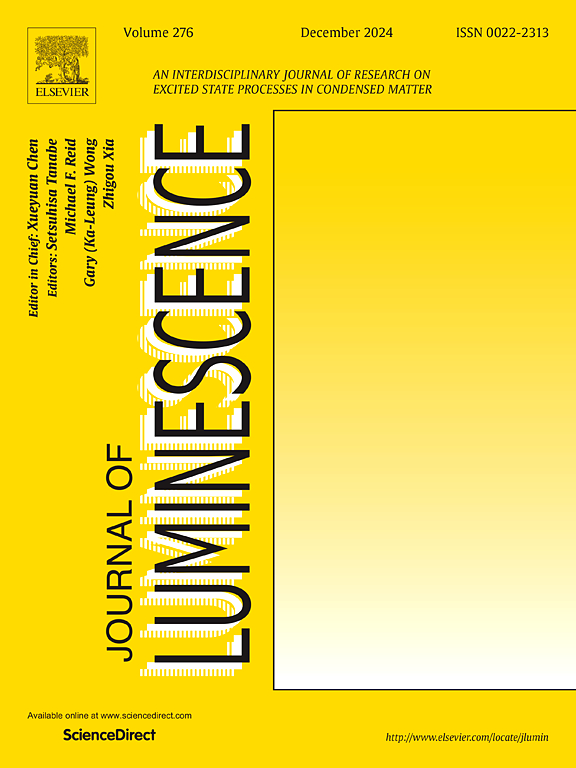Optical properties of porphyrin aluminum metal-organic frameworks by “conventional” and synchronous luminescence spectroscopy, and effect of sorption of diethyl sulfide
IF 3.6
3区 物理与天体物理
Q2 OPTICS
引用次数: 0
Abstract
Metal-organic frameworks (MOFs) are advanced structured coordination polymers that contain metals and organic linkers and feature interesting optical properties. Particularly, MOFs with linkers of complex structure, which absorb and emit light in the optical range, are promising for opto-electronics, chemo-sensing toxic vapors and liquids, sorption-based removal of hazardous compounds, and beyond. Here, we report studies of optical properties of two porphyrin MOFs using “conventional” excitation-emission matrix (EEM) spectra, from the near-UV through visible and into the near-infrared (NIR) range. Namely, the porphyrin aluminum MOF without metal in the porphyrin ring, compound 2 actAl-MOF-TCPPH2 absorbs light in the near-UV range due to the Soret band and, additionally, throughout the visible range. Its photoluminescence (PL) occurs in the NIR range via the purely electronic Q(0-0) and the first vibronic Q(0–1) bands. Further, the related compound 4 actAl-MOF-TCPPCu with Cu2+ cation in the porphyrin ring exhibits a strong, a factor 50 quenching of the PL signal, due to the paramagnetic copper cation. Nevertheless, it shows the characteristic emission via both the Q(0-0) and Q(0–1) bands. Further, compound 4 adsorbs vapor of volatile organic sulfur compound diethyl sulfide (DES), forming the stoichiometric absorption complex. Binding DES to the metalloporphyrin ring in this complex is detected based on the EEM spectra. Next, the common drawbacks of the EEM spectra, e.g. wide and overlapping emission bands and peaks due to diffraction grating artifact, have been overcome by the advanced method. Namely, the solid-state synchronous luminescence spectroscopy (SS-SLS) allows to successfully resolve both Q-bands in these MOFs and remove spectral artifacts. Additionally, the SS-SLS allows to get insight into the origin of an additional NIR emission band due to the interaction of each compound with molecular oxygen. For both porphyrin MOFs, the comprehensive scheme of optical (absorption and emission) transitions was obtained which includes the Soret band, two Q-bands, and the emission band involving oxygen.
用“常规”和同步发光光谱法研究卟啉铝金属-有机骨架的光学性质及二乙基硫化物的吸附效应
金属有机骨架(mof)是一种包含金属和有机连接体的高级结构配位聚合物,具有有趣的光学性质。特别是,具有复杂结构连接体的mof,可以吸收和发射光学范围内的光,在光电子,化学传感有毒蒸汽和液体,基于吸附的有害化合物去除等方面具有前景。在这里,我们报告了两种卟啉mof的光学性质的研究,使用“传统的”激发-发射矩阵(EEM)光谱,从近紫外到可见光和近红外(NIR)范围。即卟啉环中没有金属的卟啉铝MOF,化合物2 actAl-MOF-TCPPH2由于Soret波段吸收近紫外范围内的光,并且在整个可见光范围内吸收光。它的光致发光(PL)发生在近红外范围内,通过纯电子Q(0-0)和第一振动Q(0-1)波段。此外,相关化合物4 actAl-MOF-TCPPCu在卟啉环上具有Cu2+阳离子,由于顺磁性铜阳离子,PL信号表现出强的,因子50的猝灭。然而,它在Q(0-0)和Q(0-1)波段都显示出特征发射。此外,化合物4吸附挥发性有机硫化合物二乙基硫化物(DES)的蒸气,形成化学计量吸收配合物。结合DES金属卟啉环在该配合物检测基于EEM光谱。其次,该方法克服了EEM光谱的常见缺点,如由于衍射光栅伪影导致的发射带和峰宽且重叠。也就是说,固态同步发光光谱(SS-SLS)可以成功地解析这些mof中的两个q波段并去除光谱伪影。此外,SS-SLS允许深入了解由于每种化合物与分子氧相互作用而产生的额外近红外发射带的起源。得到了两种卟啉mof的综合光学(吸收和发射)跃迁方案,包括Soret带、两个q带和含氧的发射带。
本文章由计算机程序翻译,如有差异,请以英文原文为准。
求助全文
约1分钟内获得全文
求助全文
来源期刊

Journal of Luminescence
物理-光学
CiteScore
6.70
自引率
13.90%
发文量
850
审稿时长
3.8 months
期刊介绍:
The purpose of the Journal of Luminescence is to provide a means of communication between scientists in different disciplines who share a common interest in the electronic excited states of molecular, ionic and covalent systems, whether crystalline, amorphous, or liquid.
We invite original papers and reviews on such subjects as: exciton and polariton dynamics, dynamics of localized excited states, energy and charge transport in ordered and disordered systems, radiative and non-radiative recombination, relaxation processes, vibronic interactions in electronic excited states, photochemistry in condensed systems, excited state resonance, double resonance, spin dynamics, selective excitation spectroscopy, hole burning, coherent processes in excited states, (e.g. coherent optical transients, photon echoes, transient gratings), multiphoton processes, optical bistability, photochromism, and new techniques for the study of excited states. This list is not intended to be exhaustive. Papers in the traditional areas of optical spectroscopy (absorption, MCD, luminescence, Raman scattering) are welcome. Papers on applications (phosphors, scintillators, electro- and cathodo-luminescence, radiography, bioimaging, solar energy, energy conversion, etc.) are also welcome if they present results of scientific, rather than only technological interest. However, papers containing purely theoretical results, not related to phenomena in the excited states, as well as papers using luminescence spectroscopy to perform routine analytical chemistry or biochemistry procedures, are outside the scope of the journal. Some exceptions will be possible at the discretion of the editors.
 求助内容:
求助内容: 应助结果提醒方式:
应助结果提醒方式:


